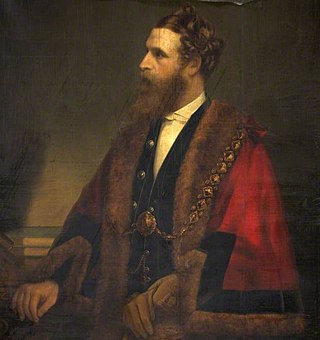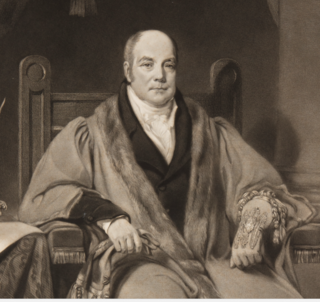
The Clifton Suspension Bridge is a suspension bridge spanning the Avon Gorge and the River Avon, linking Clifton in Bristol to Leigh Woods in North Somerset. Since opening in 1864, it has been a toll bridge, the income from which provides funds for its maintenance. The bridge is built to a design by William Henry Barlow and John Hawkshaw, based on an earlier design by Isambard Kingdom Brunel. It is a Grade I listed building and forms part of the B3129 road.

The Mansion House is a house on Dawson Street, Dublin, which has been the official residence of the Lord Mayor of Dublin since 1715, and was also the meeting place of the Dáil Éireann from 1919 until 1922.

Clifton Hill House is a Grade I listed Palladian villa in the Clifton area of Bristol, England. It was the first hall of residence for women in south-west England in 1909 due to the efforts of May Staveley. It is still used as a hall of residence by the University of Bristol.

Clifton is both a suburb of Bristol, England, and the name of one of the city's thirty-five council wards. The Clifton ward also includes the areas of Cliftonwood and Hotwells. The eastern part of the suburb lies within the ward of Clifton Down.

Queen Square is a 2.4 hectares Georgian square in the centre of Bristol, England. Following the 1831 riot, Queen Square declined through the latter part of the 19th century, was threatened with a main line railway station, but then bisected by a dual carriageway in the 1930s. By 1991 20,000 vehicles including scheduled buses were crossing the square every day, and over 30% of the buildings around it were vacant.
The Bristol riots refer to a number of significant riots in the city of Bristol in England.
Lieutenant-Colonel Thomas Brereton (1782–1832) was an officer of the British Army.
This is a list of civic sheriffs and high sheriffs of the County of the City of Bristol, England.

The Alderman Proctor's Drinking Fountain is a historic building on Clifton Down, Bristol, England.

The Engineers House is a historic building, previously known as Camp House, on The Promenade, Clifton Down, Bristol, England. It has been designated as a Grade II* listed building.
Halls of residence at the University of Bristol are generally located within three distinct areas of Bristol, the City Centre, Clifton and Stoke Bishop.

The Mansion House is a historic building in Ffynone Road in Swansea, Wales. The building was commissioned as a private residence but, since 1922, it has accommodated the official residence of the Lord Mayor of Swansea.

The Mansion House is a property in Stow Park Circle in Newport, Wales. It was the official residence of the Mayor of Newport, South Wales until 2009 and has since become the local register office.
Bristol City Council, formerly known as The Bristol Corporation, is the local government authority governing the city of Bristol, England. Following the Norman Conquest of England in 1066, successive royal charters granted increasing rights of local governance to Bristol. County status was attained in 1373 and city status in the early sixteenth century. Bristol Corporation was established in the nineteenth century and the office of Lord Mayor was created in 1888. Following a brief period as part of the county of Avon in the late twentieth century, Bristol regained its status as a city and county in 1996.

William Killigrew Wait was a British politician and merchant in Bristol.

The 1831 reform riots occurred after the Second Reform Bill was defeated in Parliament in October 1831. There were civil disturbances in London, Leicester, Yeovil, Sherborne, Exeter, Bath and Worcester and riots at Nottingham, Derby and Bristol. Targets included Nottingham Castle, home of the anti-reform Duke of Newcastle, other private houses and jails. In Bristol, three days of rioting followed the arrival in the city of the anti-reform judge Charles Wetherell; a significant portion of the city centre was burnt, £300,000 of damage inflicted and up to 250 casualties occurred.

The 1831 Bristol riots took place on 29–31 October 1831 and were part of the 1831 reform riots in England. The riots arose after the second Reform Bill was voted down in the House of Lords, stalling efforts at electoral reform. The arrival of the anti-reform judge Charles Wetherell in the city on 29 October led to a protest, which degenerated into a riot. The civic and military authorities were poorly focused and uncoordinated and lost control of the city. Order was restored on the third day by a combination of a posse comitatus of the city's middle-class citizens and military forces.
Charles Pinney was a British merchant and local politician in Bristol, England. He was a partner in a family business that ran sugar plantations in the West Indies and owned a number of slaves. Pinney was selected as mayor of Bristol in 1831 and within weeks had to manage the response to major riots. Public order was lost for a number of days and significant damage caused to the city centre. Pinney was charged with neglect of duty over his actions but was acquitted at trial. He returned to local government as an alderman, holding the position until 1853.

Thomas Daniel was a shipping magnate, financier and sugar merchant in Bristol he was known as the "King of Bristol" and later in life "Father of Bristol" because of his omnipotence in corporate affairs for over 50 years. held estates over 6,000 acres across Bristol, Devon, Somerset and Gloucestershire.

The Mansion House is a historic building in Fernwood Road in Jesmond, Newcastle upon Tyne, a city in Tyne and Wear, in England. The building, which accommodates the official residence of the Lord Mayor of Newcastle upon Tyne, is a locally listed building.















